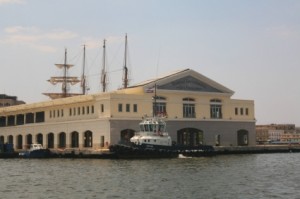
The Terminal Sierra Maestra cruise port in Havana. Photo © Christopher P. Baker.
Last week, the Thomson Dream cruise ship berthed in Havana carrying 1,500 passengers, resurrecting a new era for Cuba as a popular venue for cruising. At least that’s the hope of the Cuban government, which rolled out the red carpet with salsa bands and a youthful cabaret show to welcome passengers as they stepped onto the cobbled streets of Habana Vieja.The ship, chartered by England’s Thomson Cruises, is the largest cruise ship to dock in Havana in years. And in November 2010, Spanish start-up cruise line Happy Cruises, brought its 800-passenger cruise ship Gemini to Havana, where it will home port for eight-day trips around the Caribbean, calling at Cozumel and Grand Cayman. At the welcoming ceremony, Cuban officials said that they hope the Gemini represents a reversal of the decline in Cuba’s cruise business.
Cuba’s cruise industry has been a laggard while tourism to the island has boomed during the past two decades, notwithstanding Cuba’s long history as a cruising destination.
Executives from most (if not all) major U.S. cruise companies have already had talks in Havana, although none has publicly acknowledged this or talked of specific plans to begin cruises to Cuba.Before World War II, Havana evolved as a major port for ships of the Cunard Line and Ward Line (Cunard’s Caronia, for example, sailed every Saturday from New York to Havana.) The P&O (Peninsular & Occidental Steamship Co) offered daily overnight cruises from Key West and Tampa, and the Clyde Line had departures from Miami nightly. (Comedy couple Lucille Ball and Desi Arnez famously met when she took a cruise to Cuba in 1940, as regaled in a 1957 “I Love Lucy” program titled “Luci Takes a Cruise to Havana.”)The Cuban Revolution (and President Kennedy’s U.S. embargo) put an end to the lucrative traffic. In September 1962, the City of Havana ferry was the last passenger vessel to sail between Havana and the United States. Since then, no cruise ship has sailed to Cuba from any U.S. port.
Under long-standing U.S. law, U.S. registered or owned aircraft and ships are expressively prohibited from berthing in Cuba. And foreign cruise companies have been hesitant to include Cuba-related itineraries, since U.S. law prevents vessels that have berthed in Cuban waters from visiting U.S. ports for six months, regardless of the ship’s registry. (Thus, in October 2006 Pullmantur had to withdraw its Holiday Dream from Cuban waters after being bought by Miami-based Royal Caribbean. And Italy’s Costa, which had plans to invest in a $62 million terminal expansion in Havana, had to pull its ships after it became part of the Carnival Group.)
Nonetheless, several foreign cruise companies have featured Cuba on their itineraries. However, none has lasted more than one or two seasons. The hassles of operating in Cuba have apparently been too much. (In fact, although Thompson Cruises launched three Cuba itineraries with the Thompson Dream, the company has already announced that its Cuba programs will be axed next year.)
In 2005 Fidel Castro belittled the cruise industry and complained that cruise ships were “floating hotels, floating restaurants, floating theaters, floating diversions” that “visit countries to leave their trash, their empty cans and papers for a few miserable cents.” He said cruise passengers were no longer welcome, apparently because they didn’t spend enough while ashore. He even canceled a contract with the Italian firm that operated the island’s cruise terminals.
Thus, cruise arrivals plummeted from 122 port calls and delivering 102,440 passengers in 2005 (generating $15 million) to 23 port calls and 11,000 passengers in 2007, primarily due to the withdrawal of Pullman.
Now, Raúl Castro’s cash-strapped government appears to be taking a rosier view than Fidel.
An entirely new destination will open to cruise ship companies once U.S. relaxes existing restrictions. Executives from most (if not all) major U.S. cruise companies have already had talks in Havana, although none has publicly acknowledged this or talked of specific plans to begin cruises to Cuba. There is no sign, or possibility, that U.S. cruise companies will be able to initiate cruises to Cuba any time soon. And any U.S. citizen thinking of hopping a foreign cruise ship to Cuba should be aware that a prohibition for U.S. citizens regarding “all transactions relating to travel-related tourist transactions in Cuba” applies.